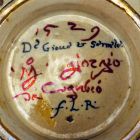
Istoriato plate - the scene of Jupiter and Semele
| Accession Nr.: | 4402 |
|---|---|
| Artist/Maker: |
Andreoli, Giorgio (1465 - 1553) / luster painter Avelli, Francesco Xanto (1481 - 1546) / ceramist |
| Inscription: | a tál talpán és peremén kékkel, ill. vörös lüszterrel: De Giove e Semele - f. L. R.; 1529 M. o. Giorgio da Ugubio ( sic! ) |
|---|---|
| Materials: | majolica |
| Techniques: | painted with lustre; thrown; tin-glazed |
| Dimensions: |
height: 5 cm
diameter: 26 cm
base diameter: 13 cm
|
High-fired tin-glazed ceramics are of Middle Eastern origin. Maiolica was originally the name for lustre-finish Moorish pots shipped to Italy from Mallorca, but the name became linked with Italian Renaissance pottery. Providing a major step forward from the simple yellow, green and brown of lead glazes, tin-glazed pottery spread first through Italy and then Europe. The white cover glaze enabled the splendid, vivid colours to come through, and maiolica wares became favoured ornaments in royal courts in the early 15th century. The istoriato style, involving narratives painted on to the dish in one or more scenes was one of the most interesting forms of ornamentation used. Maiolica painters, following instructions from their patrons, took the subjects of their pictures largely from classical authors. The stories of Ovid, Virgil, Valerius Maximus, Livy and Suetonius come to life on the istoriato wares, mainly bowls, but Biblical scenes are also quite common. This outstanding piece from the maiolica collection bears a scene from a story by Ovid, the moment when Jupiter, armed with his powers of terror and destruction, appears before the object of his love, Semele. (Ovid, Metamorphoses III, 298–301). Semele, daughter of King Kadmos, at the persuasion of the jealous and hurt Juno, asks her suitor to show himself as a god, not knowing that the destructive fire of lightning could burn her mortal body. The denouement of the drama is hinted at by the beautiful princess’ sarcophagus-like bed. Another interesting feature of the bowl is that it was first taken to the workshop of Giorgio Andreoli in Gubbio, where some details of the composition, mainly the outlines, were enhanced with lustre painting and metallic-sheen decoration.
Literature
- Szerk.: Horváth Hilda, Szilágyi András: Remekművek az Iparművészeti Múzeum gyűjteményéből. (Kézirat). Iparművészeti Múzeum, Budapest, 2010. - Nr. 22. (Balla Gabriella)
- Thornton Dora, Wilson Timothy: Italian Renaissance ceramics. A Catalogue of the British Museum Collection. Vol. I. British Museum, London, 2009. - 261.
- Szerk.: Pataki Judit: Az idő sodrában. Az Iparművészeti Múzeum gyűjteményeinek története. Iparművészeti Múzeum, Budapest, 2006. - Nr. 39. (Balla Gabriella)
- Szerk.: Pataki Judit: Művészet és Mesterség. CD-ROM. Iparművészeti Múzeum, Budapest, 1999. - kerámia 6.
- Szerk.: Lovag Zsuzsa: Az Iparművészeti Múzeum. (kézirat). Iparművészeti Múzeum, Budapest, 1994. - Nr. SZ/62.
- Szerk.: Péter Márta: Reneszánsz és manierizmus. Az európai iparművészet korszakai. Iparművészeti Múzeum, Budapest, 1988. - Nr. 278. (Lovay Zsuzsanna)
- Szerk.: Voit Pál, László Emőke: Régiségek könyve. Gondolat Kiadó, Budapest, 1983. - 16. színes kép
- Szerk.: Miklós Pál: Az Iparművészeti Múzeum gyűjteményei. Magyar Helikon, Budapest, 1979. - p. 173.
- Tait G. Hugh: The Roman Lion-Hunt Dish: An Early Work by Xanto?. British Museum Society Bulletin, 21. (1976). 1976. - 3-6.
- Szerk.: Radocsay Dénes, Farkas Zsuzsanna: Az európai iparművészet remekei. Száz éves az Iparművészeti Múzeum 1872-1972. Iparművészeti Múzeum, Budapest, 1972. - Nr. 102.
- Brestyánszky Ilona: Italienische Majolikakunst. Italienische Majolika in ungarischen Sammlungen. Corvina Kiadó, Budapest, 1967. - Nr. X.
- Szerk.: Voit Pál, Csernyánszky Mária: Az Iparművészeti Múzeum mesterművei. 1896-1946. Iparművészeti Múzeum, Budapest, 1946. - p. 9.
- Szerk.: Csányi Károly: Az Országos Magyar Iparművészeti Múzeum gyűjteményei - az iparművészet rövid történetével. Iparművészeti Múzeum, Budapest, 1926. - Nr. 2.
- Radisics Jenő: Az Országos Magyar Iparművészeti Múzeum 1893. évi szerzeményei. Művészi Ipar, 9. (1894). 1894. - 103-108.

